| |
|
|
| Pennefather River |
 |
July 15 - 16 2019 |
| |
|
|
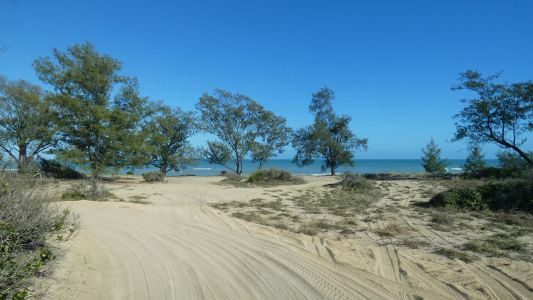 |
|
We drove a little south first, to see what was there. A few
campsites, with fireplaces. The camper trailers and tents seek shade. We
seek a breeze and sun for solar, with 50mm roof thickness we provide our own
shade as long as there is ventilation. |
| | | |
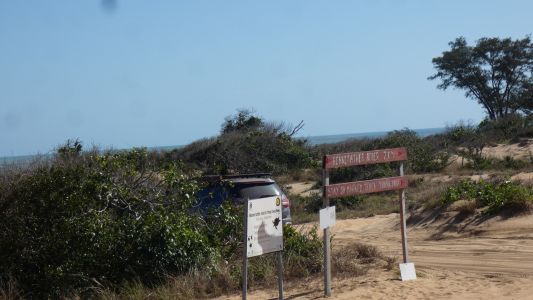 |
|
We guess this is where the main track reaches the coast.
The arrows point to the right. |
| | | |
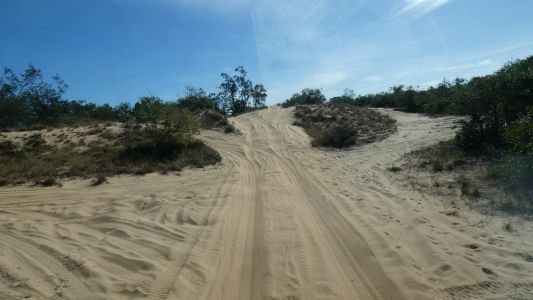 |
|
Take your pick. Sometimes the sand is softer than other
times. |
| | | |
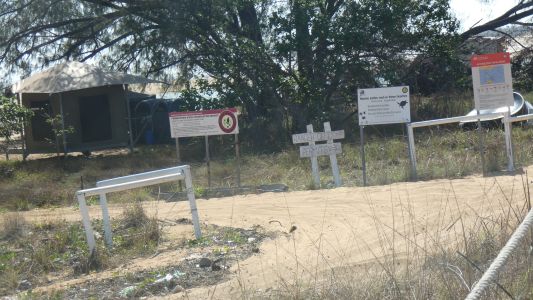 |
|
The signs reflect the times when permits were required and
rangers were in residence. There's a largish flat area near the ranger
station, and a couple of loos. Perhaps 10-12 campers, well established with
boats moored in the lagoon.
Also tents on steel platforms for glamping.
The ranger station is bordering on derelict. Looks like it was a nice
idea at one time.
There's a phone - a community phone, a module with satellite dish, solar
panels, and simple instructions for free calls. Even what to do if the
handset doesn't function.
Also water. I can't decide if the 50mm pipe disappearing into the sand of
the spit is for water supply or drainage. |
| | | |
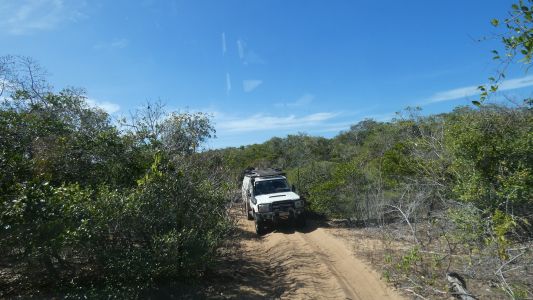 |
|
We could either drive along the beach, or take the track
behind the beach. We took the track.
A good conversation about what was in front. Shortly after passing we
turned round and found our ideal campsite. |
| | | |
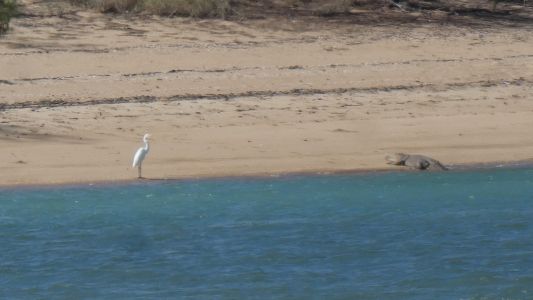 |
|
We are about 15m above the beach, on top of a dune.
Overlooking the lagoon. We are in the dress circle. The croc and the egret
are on the far side of the lagoon, about 300m away.
There's a couple more crocs further east in the lagoon. |
| | | |
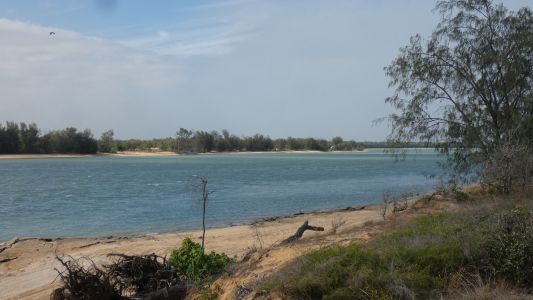 |
|
The view across and inland. |
| | | |
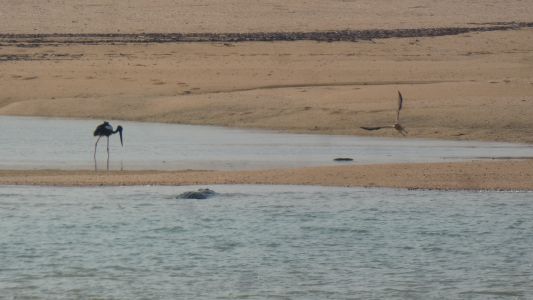 |
|
All in slow motion. The black-necked crane strolled around
the edge of the small pond. Pausing to watch and occasionally catch
something. The croc nonchalently moved up and down outside until the tide
came in a bit and it could paddle easily into the small pond. It then got
bored and moved outside again. I guess it caught fish moving into the pond
(do crocs eat cranes?). The sea eagle or kite picked at something large on
the sand then flew off. We feel a little privileged as the performance
hasn't been repeated. |
| | | |
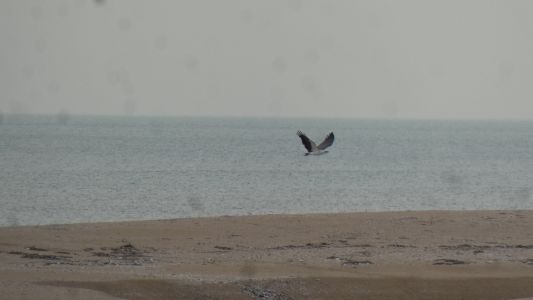 |
|
We see lots of kites. But this is a white-bellied sea
eagle. |
| | | |
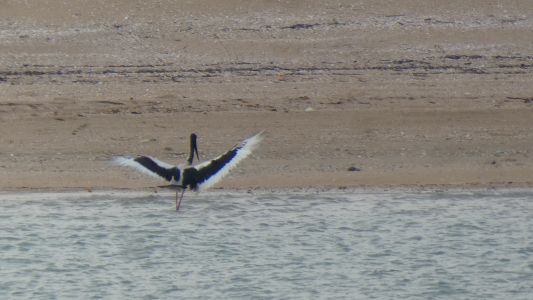 |
|
Every so often the crane moved further along the edge of
the lagoon. A few flaps of wings and a graceful float back to land, there's
an offshore breeze in the afternoons. Probably further from the croc than
we think from our angle. |
| | | |
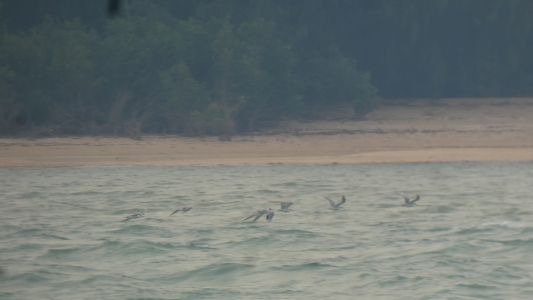 |
|
We watched the terns fishing when further south on the
beach front. Now we see them returning home, we assume they roost somewhere
further into the lagoon. There's a steady procession, adding up to many
hundreds of birds. |
| | | |
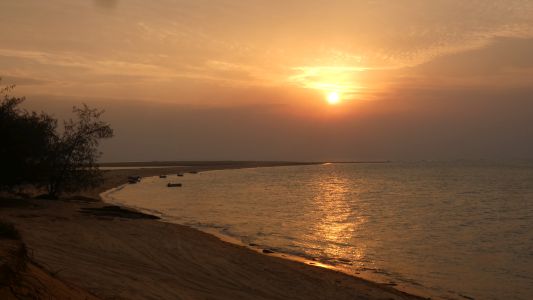 |
|
And we watch the sun set over the spit. Boats moored in the
calm water. |
| | | |
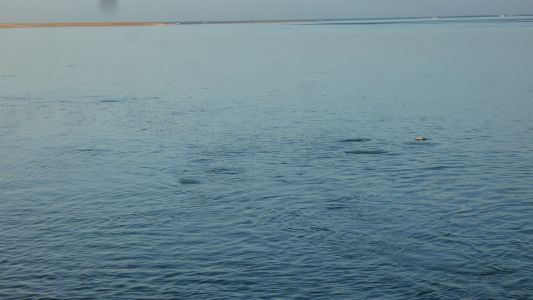 |
|
The tide flows quite fast on the way out. There's a little
point just below us. As the water passes its disturbed by small fish near
the surface, which are in turn disturbed by larger fish. |
| | | |
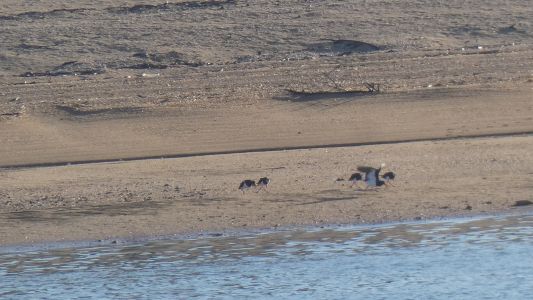 |
|
Opposite a family of pied oyster catchers play catch the
crab. Running across the beach in some sort of team effort. We also watch
individuals pecking at the oysters on the rocks below us. |
| | | |
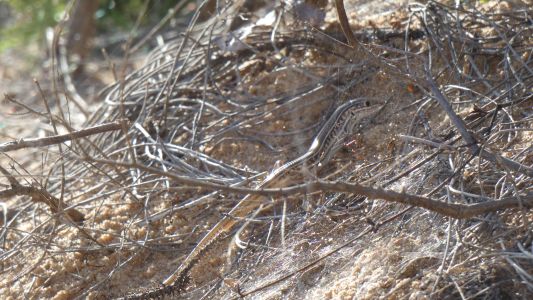 |
|
Our attention briefly diverted to a small lizard that came
to visit. We tried to remember names from the desert, but totally failed. |
| | | |
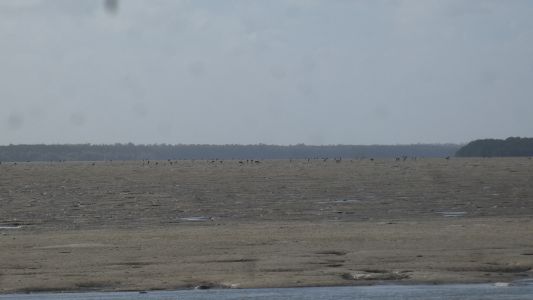 |
|
We find enough energy to walk along the beach deeper into
the lagoon. A couple of km. Initially we thought more black cranes but
then decided they are probably Brolgas. We've only ever seen them as pairs
or threes. To see 200 - 300 meant we had to read the bird book to check
their habits. So unexpected. |
| | | |
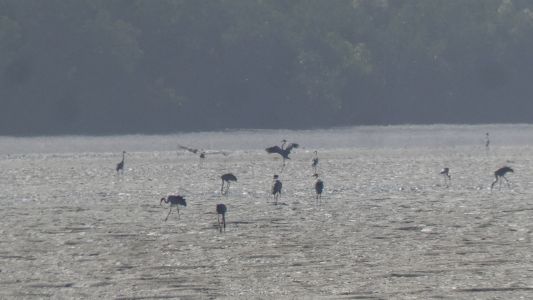 |
|
They are at the limit of the camera and the light is in the
wrong direction. Between us and them are mud flats and mangroves stop us
walking further along the lagoon edge. There aren't many birds this size
in Australia. We think we can pick out hints of red around the head and grey
wings. None of the distinctive black and white of yesterday's stork. |
| | | |
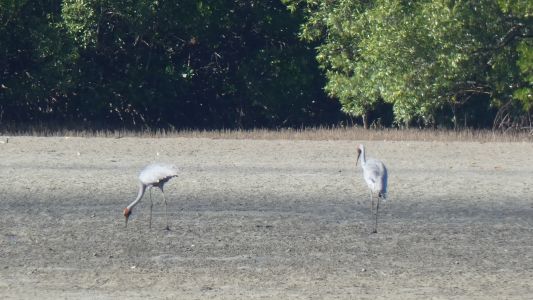 |
|
These two were a bit separate to the rest, but closer to
the camera. |
| | | |
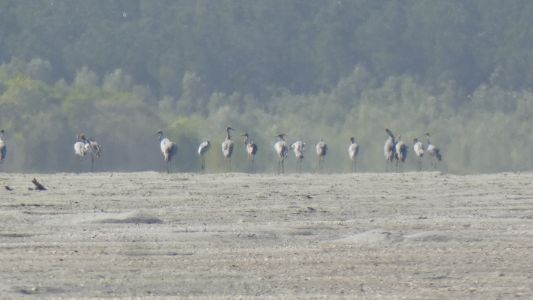 |
|
We'll go back on another day, at a different time, for
another look. We also feel inclined to investigate the early morning
sounds from far up the lagoon which we think sound like the honking of
geese. Apparently magpie geese inhabit the wetlands surrounding the lagoon. |
| | | |
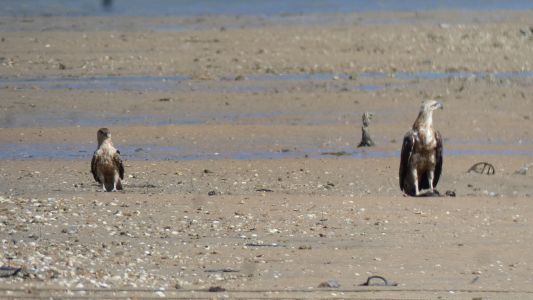 |
|
Even the kites are comfortable sitting on the sand. They
are not garden gnomes. We can't account for the difference in size. |
| | | |
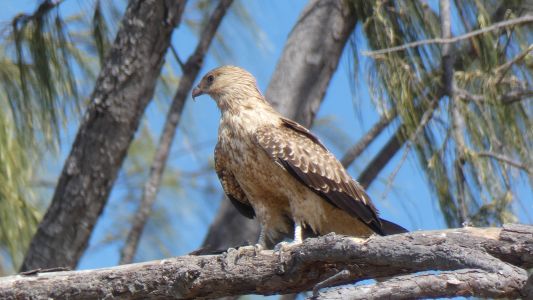 |
|
Though they also use the trees. |
| | | |
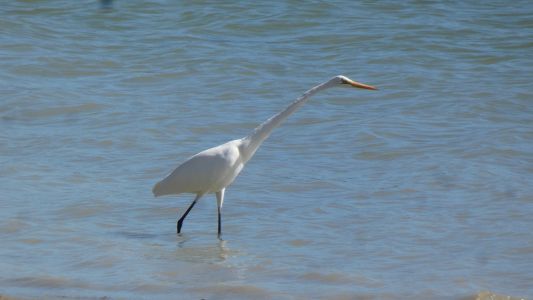 |
|
Fishing seems to be the primary occupation for campers. And
for egrets. |
| | | |
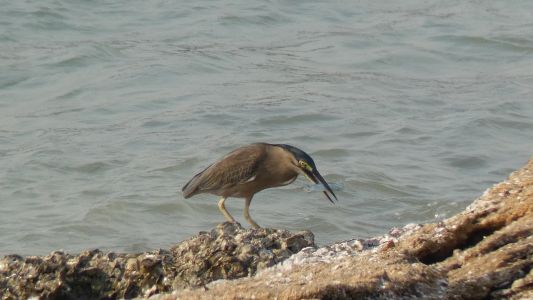 |
|
And mangrove herons - this one has just caught a garfish. |
| | | |
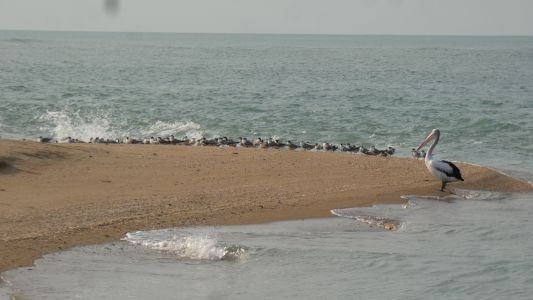 |
|
On our evening stroll we see the terns take a well earned
rest. |
| | | |
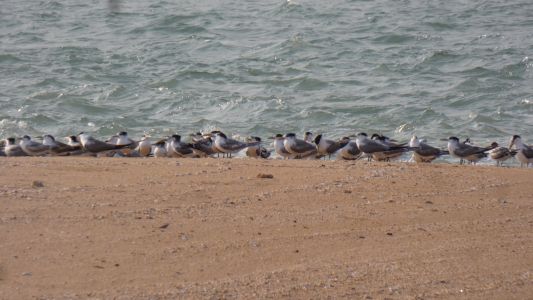 |
|
There are crested terns, as well as other terns, and
occasional seagull. |
| | | |
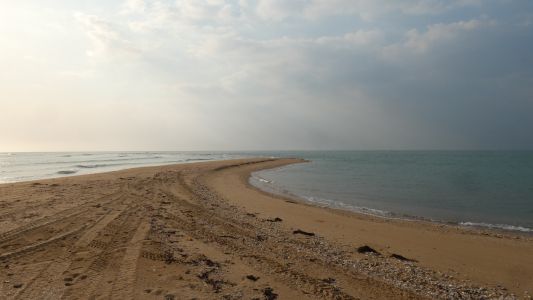 |
|
They are at the end of the spit. The lagoon empties to
carve the curve on the right hand side and move sand outwards. The northerly
flow of the tide carves the left hand, outer, side. Perhaps bringing sand
from the south. Not necessarily quite like that, but basically two currents
meet. The tide is well in. The spit curves around much further, visible at
low tide.
Why the river and its oversize lagoon are here in the first place is a
mystery to us. Perhaps just a small quirk, there's a rocky point a little to
the south, which became something bigger. |
| | | |
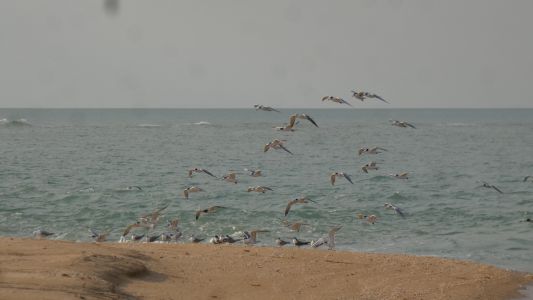 |
|
Disturbed by an approaching couple, in a landcruiser, keen
to fish off the spit the terns briefly return. As we leave the fishing
couple take the place of the terns. |
| | | |
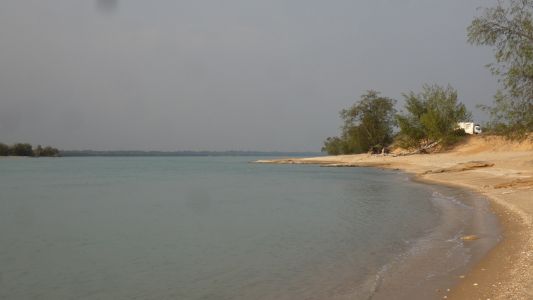 |
|
Our campsite. The far end of the lagoon is a bit hazy, some
burning happening inland. |
| | | |
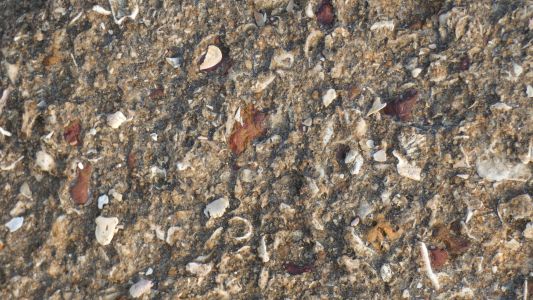 |
|
The rock below us, and lining the lagoon on our side, is
sandstone with lots of shells embedded. Just at water level, above is sand.
Over many years the lagoon has probably changed shape many times as rock is
formed and eroded, and sea levels change.
The sand is quite coarse and must take high winds to move. Perhaps water
borne. |
| | | |
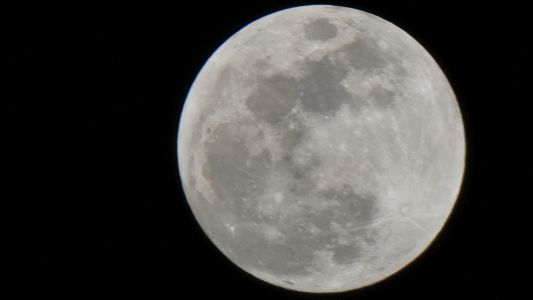 |
|
Nearing the 50th anniversary, in a couple of days, of the
first moon landing by people, we take a peek at the full moon. The camera
zoom is a bit sticky and frustrating - time for another new one - but is
working well enough for now. Its the first time the moon has really been
bright enough, and we've been inclined, for the camera to focus. Along
with many others in the world in my youth I had a poster of "earth rising"
taken from orbit around the moon. Space exploration has all happened in my
lifetime, even though I had nothing to do with it. |
| | | |
| Pennefather River |
 |
July 17 - 18 2019 |
| | | |